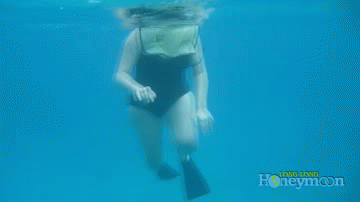For many of us, our favorite souvenirs from travel are the photographs we bring home. Over the years doing the Long Long Honeymoon website, I’ve used a lot of gear – and in this series of articles, we discuss my favorite (and/or recommended) cameras.
Today’s recommendation is a simple point-and-shoot, one that goes where tablets and smartphones cannot: a waterproof camera. We occasionally use waterproof cameras to shoot our LongLongHoneymoon.com website. They are fun travel cameras for anyone who loves the outdoors.

U.S. Virgin Islands National Park (photo taken with a simple Panasonic TS series waterproof camera). You can hitch a boat to these buoys and use ’em as your “campsite!”
Just a few years ago, waterproofing a camera meant you needed a bulky and expensive external housing. Today you can buy waterproof digital cameras for a reasonable cost. The Kodak EasyShare Sport C123 costs less than $80.

This Kodak camera is WATERPROOF – and it’s CHEAP! A lot of fun for a low price. (CLICK THE PIC for more info.)
There are many nice choices from Canon, Nikon, Panasonic, Kodak, and Olympus. Personally I have enjoyed using the Panasonic Lumix TS series (like the Lumix TS20). I’ve also owned the Fuji Finepix XP60. It’s nothing fancy, but it does the trick.
No special housing is required. These cameras are waterproof (and typically shockproof and freezeproof) straight from the factory. They are very simple to operate, just like any traditional point-and-shoot camera.
Are these great cameras? No! I want to be clear on this point. Temper your expectations. I’m not claiming that these cameras are any professional’s weapon of choice in most circumstances. I doubt you will capture a National Geographic cover image with these cameras. These are dinky point-and-shoot cams with small image sensors and many compromises. If you want spectacular underwater images, consider a Nikon D800E and a matching Ikelite underwater housing. Of course, at the moment that combination will set you back about $5000. These point-and-shoot cameras are about $4900 cheaper, money with which you can buy a small car or spend a month in Tahiti.
So why own a waterproof camera? Quite simply, you’ll get special shots that no other type of camera can deliver. You can take these cameras to places you’d never dare take your phone.
These consumer cameras are typically waterproof to shallow depths, like 10 or 20 feet. While you probably wouldn’t take them scuba diving, they are ideal for activities like swimming, snorkeling, rafting and kayaking. Since they are waterproof, they also come in handy on a rainy day.
Probably their most popular use is snapping photos of kids and grandkids having fun in the swimming pool, ocean, river or lake. Yes, you can actually snap photos underwater. It’s a lot of fun to bring a camera into water with no worries.
Waterproof cameras have a couple of other bonuses. Since they are usually shockproof, they can be dropped small distances (five feet or so) without suffering damage. So you can hand them off to even the youngest kids without fear. Children love using the cameras.
Many of these cameras are also freezeproof. While I have no intentions of taking photos in Antarctica any time soon, I’m sure that freezeproofing is welcome during winter. If you find yourself hanging out with a bunch of penguins, you’ll be all set.
Are there downsides to these cheap waterproof cameras? A few. Of course, these are simple point-and-shoot affairs that offer few user controls. These are not powerful full featured cameras. They are quite basic in design, with small image sensors. You cannot change lenses or get too fancy with manual adjustments. They are more about “snaphots” than photography, if you know what I mean. But if you master the various menu settings and use the cameras properly, they are capable of creating quality images.

They are waterproof, shockproof, and freezeproof – but they aren’t indestructible. Always make sure compartments are closed and the seals are in good shape.
It’s important to remember that while they are rugged, waterproof cameras are not indestructible! If water somehow seeps into the interior of these cameras, they will die. So it’s important that you carefully follow maintenance instructions before and after submerging them in water (especially salt water). The instructions are mostly common sense – you must keep the camera internals dry and the battery compartment seal in good condition. Always make certain the camera’s battery compartment is properly closed before leaping into the pool. Over time the protective seals weaken; it’s not a bad idea to replace the seals every year or so.
Because they are not indestructible, I recommend you consider less expensive models. Do you really need wifi, GPS, a blender, corkscrew, toothpick and CB radio built into your waterproof camera? Not really. You just need a simple camera that takes pictures in the water. There’s no need to pay for a lot of features that you won’t use. There’s a reason the $77 Kodak EasyShare Sport C123 is so popular. It may not be the greatest camera you’ll ever own; but hey, you can take it in the ocean!
I don’t use my waterproof camera every day, but I’m always glad to have one in my bag. It gets shots that would be impossible otherwise.




